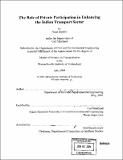| dc.contributor.advisor | Carl Martland. | en_US |
| dc.contributor.author | Sharma, Nand, 1979- | en_US |
| dc.contributor.other | Massachusetts Institute of Technology. Dept. of Civil and Environmental Engineering. | en_US |
| dc.date.accessioned | 2005-06-02T18:50:32Z | |
| dc.date.available | 2005-06-02T18:50:32Z | |
| dc.date.copyright | 2004 | en_US |
| dc.date.issued | 2004 | en_US |
| dc.identifier.uri | http://hdl.handle.net/1721.1/17830 | |
| dc.description | Thesis (S.M.)--Massachusetts Institute of Technology, Dept. of Civil and Environmental Engineering, 2004. | en_US |
| dc.description | Includes bibliographical references (p. 145-148). | en_US |
| dc.description.abstract | The Indian transport sector, one of the largest transport networks in the world, faces some serious issues. These may be identified as follows: * Unmet demand for service and infrastructure * Conflicting responsibilities * Inadequate resource mobilization * Poor Asset Management * Inadequate imposition of accountability Increasing the level of private participation in transport sector is one of the possible solutions to solve these problems. At present, private participation in the transport sector in India is low and generally restricted to small projects. Although various steps have been taken to attract the private sector participation in transport sector in India, various indirect and direct constraints exist in its implementation. Indirect constraints include low economic growth, higher poverty rate and high population growth rate. The direct constraints include planning and the institutional issues, methodological or procedural issues, financial constraints, social and the political constraints. In order to alleviate these constraints various steps can be taken. At the planning and the institutional level, India needs to develop a strategic planning network. At the legal and the regulatory level, there is a need for well-drafted laws and regulations related to private sector participation. Also, the amount of government support needs to be clearly defined for the toll road projects in India. Traffic forecasting techniques should be improved, and the government should promote public acceptance for private participation in transport sector. | en_US |
| dc.description.statementofresponsibility | by Nand Sharma. | en_US |
| dc.format.extent | 148 p. | en_US |
| dc.format.extent | 6684060 bytes | |
| dc.format.extent | 6700521 bytes | |
| dc.format.mimetype | application/pdf | |
| dc.format.mimetype | application/pdf | |
| dc.language.iso | eng | en_US |
| dc.publisher | Massachusetts Institute of Technology | en_US |
| dc.rights | M.I.T. theses are protected by copyright. They may be viewed from this source for any purpose, but reproduction or distribution in any format is prohibited without written permission. See provided URL for inquiries about permission. | en_US |
| dc.rights.uri | http://dspace.mit.edu/handle/1721.1/7582 | |
| dc.subject | Civil and Environmental Engineering. | en_US |
| dc.title | The role of private participation in enhancing the Indian transport sector | en_US |
| dc.type | Thesis | en_US |
| dc.description.degree | S.M. | en_US |
| dc.contributor.department | Massachusetts Institute of Technology. Department of Civil and Environmental Engineering | |
| dc.identifier.oclc | 56566159 | en_US |
